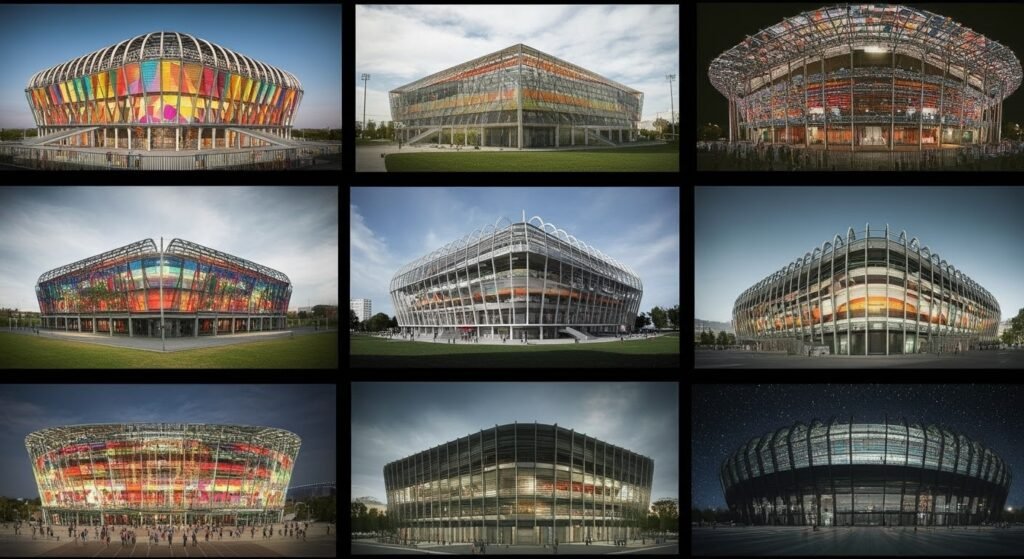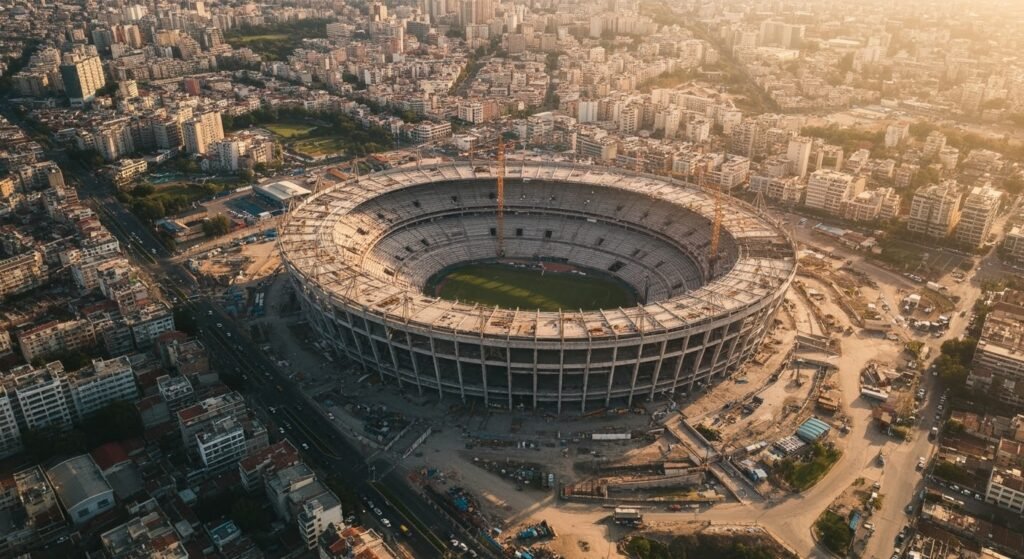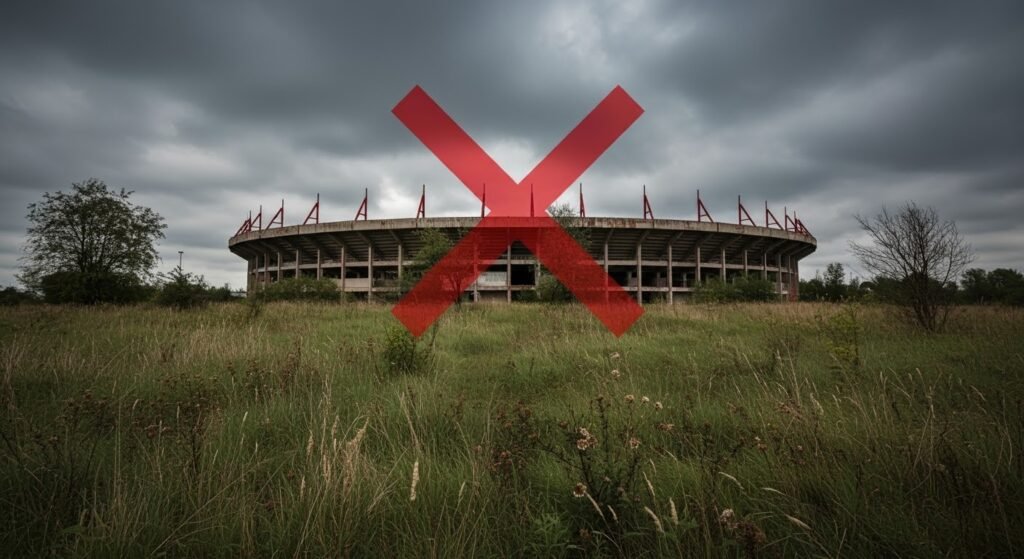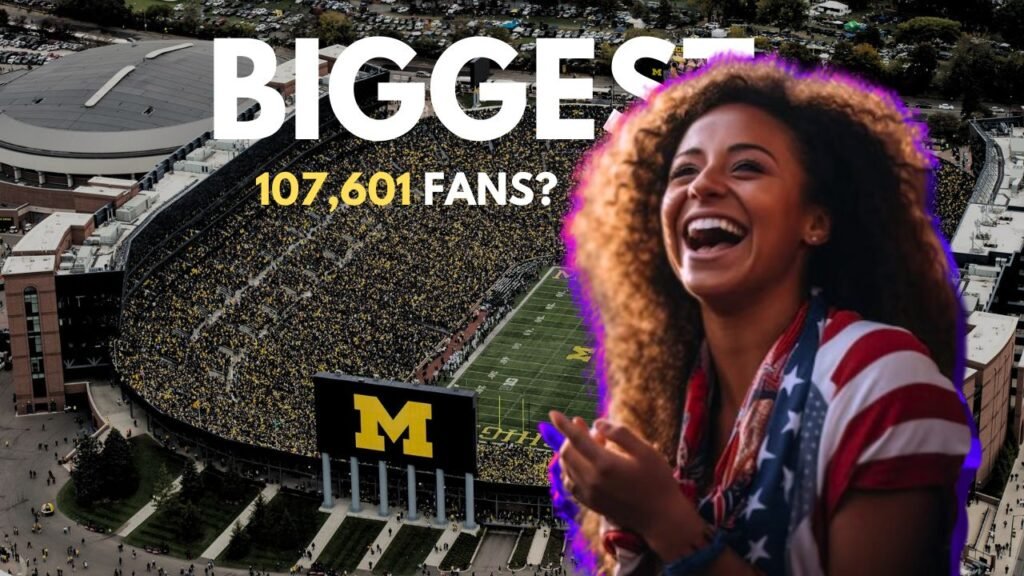I. Executive Summary: Key Findings
The selection process for the 2026 FIFA World Cup host cities, jointly managed by Canada, Mexico, and the United States, was characterized by a stringent evaluation that led to the rejection or withdrawal of numerous stadium bids.
Key factors contributing to these outcomes included a pervasive concern among cities regarding FIFA’s financial demands and the associated liabilities, often perceived as non-negotiable and lacking transparency.
Furthermore, the suitability and modernity of stadium infrastructure, comprehensive urban logistical capabilities (including transportation and accommodation), and the nature of governmental financial and political support proved decisive.
The competitive landscape within regional clusters also played a significant role, with FIFA prioritizing established, low-risk bids and venues that aligned with its revenue optimization strategies and global brand image.

13 Rejected Stadiums for the FIFA World Cup 2026. Watch
II. Overview of the 2026 FIFA World Cup Bid Landscape
The 2026 FIFA World Cup marks a significant evolution for the tournament, being the first to feature an expanded 48-team format and the first to be jointly hosted by three nations: Canada, Mexico, and the United States.
This “United 2026” bid successfully secured hosting rights, winning against Morocco with a vote of 134–65.
The bidding process itself was notably restarted in May 2016, following the 2015 FIFA corruption case, with an explicit emphasis on ensuring a “fair, objective and transparent” selection.
This renewed approach involved several structured phases: a strategy and consultation phase from May 2016 to May 2017, enhanced bid preparation from June 2017 to December 2017, a thorough bid evaluation from March 2018 to June 2018, and the final decision in June 2018.
Initially, an extensive pool of 49 stadiums across 44 metropolitan markets was considered, which was progressively narrowed down to 23 candidate cities for the final submission.
Ultimately, 16 host cities were selected: 11 in the United States, 3 in Mexico, and 2 in Canada.

FIFA established rigorous criteria for host stadiums, encompassing minimum capacities: 80,000 for the opening match and final, 60,000 for semifinals, and 40,000 for all other matches including group stage, Round of 32, Round of 16, and quarterfinals.
Beyond capacity, the evaluation focused on crucial aspects such as financial guarantees, robust security measures, comprehensive hospitality provisions, adherence to human rights requirements, sustainable event management, and environmental protection.
The bid evaluation model itself was structured around three core components: bid compliance assessment, overall risk assessment, and a technical evaluation utilizing an objective scoring system.
The explicit mention of the bid process restarting after the 2015 FIFA corruption case underscores a critical shift in the organization’s priorities.
This context indicates that FIFA was under immense pressure to demonstrate a highly credible and transparent bidding process. The decision to expand the tournament to 48 teams and involve three co-hosts inherently amplified logistical complexities , making a low-risk bid an absolute imperative.
The United bid’s classification as “low risk” by FIFA, in stark contrast to Morocco’s “high risk” assessment, illustrates a deliberate strategy to prioritize stability, proven infrastructure, and financial reliability.
This approach was fundamental to restoring FIFA’s credibility and ensuring the smooth execution of an expanded, high-profile tournament.
Furthermore, the final selection of the 16 host cities was heavily influenced by logistical and travel considerations, leading to the organization of cities into three distinct regions: West, Central, and East.
This regional clustering represents a deliberate strategy by FIFA to minimize travel distances for participating teams and fans throughout the tournament.
Such an emphasis on geographic efficiency suggests that a city’s location and its ability to integrate seamlessly into these regional clusters were as important as its individual merits, potentially disadvantaging otherwise well-equipped cities that were geographically isolated from other selected venues.
III. Stadiums That Voluntarily Withdrew Their Bids
A notable characteristic of the 2026 World Cup bidding cycle was the voluntary withdrawal of several cities.
These withdrawals were primarily driven by concerns over financial transparency, FIFA’s perceived inflexibility, and its unwillingness to negotiate financial details.
Cities expressed apprehension about assuming excessive financial liability and unforeseen commitments, reflecting a growing reluctance among local governments to bear unquantified costs.

Chicago, Illinois (Soldier Field)
Soldier Field, with a capacity of 61,500, officially withdrew its bid on March 14, 2018. The Mayor’s office explicitly stated that FIFA “could not provide a basic level of certainty on some major unknowns that put our city and taxpayers at risk”.
This statement highlighted FIFA’s “inflexibility and unwillingness to negotiate” as clear indications that “further pursuit of the bid wasn’t in Chicago’s best interests”.
A specific demand from FIFA for a dome to be built over Soldier Field was also cited as a contributing factor to the city’s decision. The city’s withdrawal, citing FIFA’s “inflexibility” and the lack of “certainty on some major unknowns,” underscores a fundamental conflict in the bidding process.
This suggests that FIFA imposes a non-negotiable contract, requiring host cities to assume significant, potentially open-ended, financial and liability burdens without sufficient guarantees or negotiation.
The demand for a specific, costly stadium modification like a dome further exemplifies FIFA’s unilateral requirements, which cities, increasingly accountable to their taxpayers, found unacceptable.
This situation illustrates a power imbalance where FIFA leverages its global brand, expecting cities to absorb substantial risks.
Minneapolis, Minnesota (U.S. Bank Stadium)
U.S. Bank Stadium, with a capacity of 66,655 (expandable to 73,000), also withdrew on March 14, 2018.
The Minneapolis Bid Committee cited their “inability to negotiate the terms of the various bid agreements,” which “did not provide our partners, and our community, with sufficient protections from future liability and unforeseen changes in commitments”.
They specifically sought “flexibility on the financial liability caps and/or stronger estimates on anticipated costs,” indicating a desire for clearer financial parameters and risk mitigation.
The parallel reasons for withdrawal from Chicago and Minneapolis, both emphasizing financial liability, lack of transparency, and FIFA’s inflexibility, point to a systemic issue rather than isolated incidents.
This indicates that FIFA’s standard host city contract terms are inherently problematic for many municipalities, particularly regarding the assumption of “liability for safety and security incidents” and unquantified costs.
The consistent demand for “stronger estimates” suggests a perceived opacity in FIFA’s financial projections for host cities, making it difficult for local governments to justify public investment.
Montreal, Quebec (Olympic Stadium)
Montreal’s Olympic Stadium, with a capacity of 61,004 (bid book capacity: 55,822), withdrew its candidacy in July 2021.
The primary reason was the Quebec provincial government’s decision to withdraw financial support, stating that the “high cost of the event was becoming difficult for us to justify to Quebec taxpayers”.
The City of Montreal’s communications director confirmed that the withdrawal of provincial financial participation “jeopardizes the Montreal candidacy“.
This decision was made in the context of prioritizing support for Quebecers and businesses during the pandemic and economic recovery.
Montreal’s case highlights the critical role of multi-level government support, particularly financial backing, for hosting mega-events.
The provincial government’s withdrawal of funding directly led to the city’s inability to proceed, underscoring that municipal commitment alone is often insufficient.
This also reflects a broader trend of increased public and political scrutiny over large-scale public spending on sporting events, especially when competing with other societal priorities.
This implies that successful bids require not just a city’s enthusiasm but robust, unconditional financial guarantees from higher levels of government.
Washington, D.C. (Northwest Stadium / FedEx Field)
Washington D.C.’s proposed venue, FedEx Field (Northwest Stadium), with a capacity of 62,000, effectively withdrew as a standalone primary venue.
FedEx Field was cited as being in “poor condition” and “poorly maintained over the years,” with its location on the “metro area’s periphery” also noted as a disadvantage.
This unsuitability led D.C. to combine its bid with Baltimore’s M&T Bank Stadium. Washington D.C.’s initial withdrawal, specifically concerning FedEx Field, was driven by the stadium’s physical shortcomings.
This demonstrates that beyond financial disputes, the fundamental condition and suitability of a venue can lead a city to self-assess its unviability for a World Cup.
FIFA’s high standards for modern, well-maintained facilities mean that older stadiums requiring extensive, costly upgrades to meet “creature comforts” or logistical convenience are at a significant disadvantage, prompting cities to reconsider their bids or seek alternative venues.
The following table summarizes the voluntarily withdrawn bids:
| City, State/Province | Stadium | Country | Capacity (Bid Book/Current) | Primary Reason(s) for Withdrawal |
|---|---|---|---|---|
| Chicago, Illinois | Soldier Field | United States | 61,500 | Financial uncertainty, FIFA’s inflexibility, demand for dome |
| Minneapolis, Minnesota | U.S. Bank Stadium | United States | 66,655 (expandable to 73,000) | Inability to negotiate financial liability caps and cost estimates |
| Montreal, Quebec | Olympic Stadium | Canada | 61,004 (Bid book: 55,822) | Quebec provincial government withdrew financial support due to high costs |
| Washington, D.C. | Northwest Stadium (FedEx Field) | United States | 62,000 | Stadium in poor condition, poorly maintained, peripheral location |
IV. Stadiums Excluded from the Final Host City List (June 2022)
FIFA’s final selection of 16 host cities from the 23 submitted bids involved a comprehensive evaluation process that considered bid compliance, overall risk assessment, and technical evaluation.
Exclusions were often due to a combination of factors including stadium suitability, broader infrastructure limitations, political considerations, and the competitive landscape within specific regions.

Baltimore, Maryland (M&T Bank Stadium)
M&T Bank Stadium, with a capacity of 71,006 (bid book capacity: 70,976), was excluded in June 2022. Although considered a “more highly-rated” venue than D.C.’s FedEx Field, the merged Baltimore/D.C. bid was not selected.
Key deficiencies cited included “woefully inadequate” public transportation and a comparative lack of hotels in Baltimore to accommodate large crowds.
Additionally, the strong political influence of Robert Kraft, owner of the New England Patriots and Revolution (MLS) and an honorary chairman of the United bid, was suggested to have “tipped the scale in Boston’s favor” in a direct regional competition.
Baltimore’s exclusion, despite a suitable stadium, reveals a complex interplay of factors beyond just the venue itself. The “woefully inadequate” public transportation and fewer hotels highlight that FIFA evaluates the entire urban ecosystem’s readiness to handle a mega-event, not solely the stadium.
Furthermore, the explicit mention of Robert Kraft’s influence suggests that political capital, established relationships, and strategic lobbying efforts within FIFA’s decision-making circles can be decisive, especially when strong regional bids are in direct competition.
This implies that success in World Cup bidding is not purely meritocratic based on technical scores but also involves significant “soft power” and strategic positioning.
Cincinnati, Ohio (Paycor Stadium)
Paycor Stadium, with a capacity of 65,515 (bid book capacity: 67,402), was excluded in June 2022. While Cincinnati’s soccer-specific TQL Stadium is new and modern, it was deemed “too small” for FIFA’s minimum capacity requirements.
The official bid likely utilized the larger NFL venue, Paycor Stadium, but it was still not selected. Local reports also cited “disparaging comments” by USMNT captain Christian Pulisic regarding low attendance at a USA/Morocco match in Cincinnati (19,512 attendance vs. 26,000 capacity), suggesting a perceived lack of strong local enthusiasm.
Cincinnati’s rejection underscores two critical FIFA evaluation points: strict adherence to minimum stadium capacity and the demonstration of robust local market enthusiasm.
The low attendance at a USMNT match suggests that FIFA assesses not just theoretical fan bases but proven, active engagement, which directly impacts ticket sales and the overall event atmosphere.
This implies that cities must present venues that meet the hard capacity requirements and demonstrate a vibrant, committed local soccer culture to ensure a successful and profitable event for FIFA.
Denver, Colorado (Empower Field at Mile High)
Empower Field at Mile High, with a capacity of 76,125 (bid book capacity: 77,595), was excluded in June 2022. While Denver officials suggested its high elevation might have been a factor, a more significant reason was likely its geographic isolation.
The observation that “no mountain time cities” were selected points to FIFA’s preference for grouping cities for “travel purposes” to optimize tournament logistics. Furthermore, Colorado lawmakers did not approve any public funds or tax breaks for the bid, and private fundraising only reached about half of the estimated $40-45 million needed to host, placing Denver at a “competitive disadvantage” compared to states that offered financial incentives.
Denver’s rejection highlights FIFA’s pragmatic approach to tournament logistics and financial de-risking.
The absence of “mountain time cities” suggests a strategic decision to cluster venues for efficient travel, even at the expense of otherwise suitable bids.
This implies that a city’s geographic fit within FIFA’s desired logistical framework can override other positive attributes. Moreover, while not a formal “requirement,” the lack of public funding and tax breaks significantly weakened Denver’s bid.
This indicates that governmental financial commitment, even if not explicitly mandated, signals strong political will and directly reduces FIFA’s financial risk, making such bids more attractive.
Edmonton, Alberta (Commonwealth Stadium)
Commonwealth Stadium, with a capacity of 56,302 (bid book capacity: 56,418), was excluded in June 2022.
Edmonton’s bid was severely impacted by political maneuvering within Canada. Montreal’s withdrawal and Vancouver’s subsequent re-entry into the bidding process, reportedly influenced by Concacaf president Victor Montagliani, shifted the landscape.
A critical misstep was the Alberta provincial government’s commitment of $110 million in public money contingent on Edmonton hosting five of Canada’s ten games, including knockout rounds.
This was perceived as “dictating terms to FIFA,” which “hurt Edmonton’s chances,” as FIFA is described as being “like the mafia” and “isn’t used to having cities make demands”.
Additionally, Commonwealth Stadium was described as “aging” and a “concrete monolith” needing costly upgrades beyond just a natural grass pitch to meet modern FIFA standards. Edmonton’s case is a stark illustration of how political conditions and outdated infrastructure can derail a bid.
The provincial government’s attempt to impose conditions on funding directly challenged FIFA’s authority and control over the tournament, a non-negotiable aspect of their hosting agreements.
This implies that while financial support is crucial, it must be unconditional to align with FIFA’s operational model. Furthermore, the description of Commonwealth Stadium as “aging” and lacking “creature comforts” highlights FIFA’s preference for modern, amenity-rich venues that enhance the global spectacle, putting older stadiums at a significant disadvantage in a highly competitive field.
Los Angeles, California (Rose Bowl)
The Rose Bowl, a historic venue with a capacity of 92,000 (bid book capacity: 88,432), was excluded in June 2022.
Instead, SoFi Stadium, with a capacity of 70,240 (expandable to 100,240), was selected as the primary Los Angeles venue. While the Rose Bowl was initially part of a joint bid with SoFi Stadium, FIFA ultimately decided to “focus on SoFi as a venue“.
The Rose Bowl’s General Manager noted that FIFA’s model is “very challenging” as it requires “venues, cities, and taxpayers to fund FIFA World Cup specific improvements to the buildings while at the same time keeping most/all revenues from the events”.
SoFi Stadium, opened in 2020 at an estimated cost of $5.5 billion, offered a newer, more modern facility.
The selection of the newer, more expensive SoFi Stadium over the iconic Rose Bowl within the same Los Angeles metropolitan area demonstrates that FIFA not only assesses cities but also optimizes for the most commercially viable and modern venue within a strong market.
This suggests a strategic prioritization of facilities that offer superior revenue-generating potential and a premium fan experience, even if it means bypassing historically significant venues.
The comment about FIFA retaining “most/all revenues” explicitly reveals FIFA’s business model, where host cities bear investment costs while FIFA maximizes profits, favoring venues that require minimal additional investment for maximum return.
Nashville, Tennessee (Nissan Stadium)
Nissan Stadium, with a capacity of 69,143 (bid book capacity: 69,722), was excluded in June 2022. The primary factor for Nashville’s exclusion was the “uncertainty about the stadium’s future“.
The Tennessee Titans, Nissan Stadium’s primary tenant, had publicly stated the stadium was in “disrepair” and were actively seeking a new, potentially enclosed stadium.
FIFA reportedly prefers “newer enclosed stadiums“.
Nashville’s rejection due to the “uncertainty” and “disrepair” of Nissan Stadium highlights that FIFA considers the long-term viability and modern standards of a venue as a precondition for hosting.
FIFA is unlikely to commit to a stadium that faces an uncertain future, is nearing demolition, or requires substantial, unconfirmed upgrades.
This implies that host cities must present venues that are not only currently adequate but also have a stable, modern future, aligning with FIFA’s desire for pristine, high-quality backdrops for its global event and minimizing any potential disruptions or additional costs down the line.
Orlando, Florida (Camping World Stadium)
Camping World Stadium, with a capacity of 60,219 (bid book capacity: 65,000), was excluded in June 2022.
Despite renovations and a history of hosting World Cup matches in 1994, Camping World Stadium was criticized as a “pretty mediocre venue” with “concourses like a parking garage” and “brutal” summer heat.
More critically, the city lacked “solid public transportation” and “international connectivity”.
The presence of stronger, nearby bids from Miami and Atlanta also contributed to its exclusion.
Orlando’s case demonstrates that a stadium’s condition is only one component of a successful bid; the surrounding urban infrastructure is equally vital.
The lack of robust public transportation and international connectivity would severely hamper fan and team logistics, a major FIFA concern for an event of this scale.
Furthermore, the presence of strong, modern venues in nearby cities like Miami and Atlanta created a highly competitive regional landscape.
This implies that cities are not just judged on their individual merits but also on their comparative advantage within a broader geographic cluster, where comprehensive urban infrastructure and a strong regional presence of other high-quality venues can be decisive factors.
The following table summarizes the bids excluded from the final host city list:
| City, State/Province | Stadium | Country | Capacity (Bid Book/Current) | Primary Reason(s) for Exclusion |
|---|---|---|---|---|
| Baltimore, Maryland | M&T Bank Stadium | United States | 71,006 (Bid book: 70,976) | Inadequate public transportation, insufficient hotels, regional competition with Boston |
| Cincinnati, Ohio | Paycor Stadium | United States | 65,515 (Bid book: 67,402) | Insufficient stadium capacity (for TQL Stadium), perceived lack of local enthusiasm |
| Denver, Colorado | Empower Field at Mile High | United States | 76,125 (Bid book: 77,595) | Geographic isolation (no mountain time cities), lack of public financial commitment |
| Edmonton, Alberta | Commonwealth Stadium | Canada | 56,302 (Bid book: 56,418) | Conditional public funding, re-entry of Vancouver, aging stadium infrastructure |
| Los Angeles, California | Rose Bowl | United States | 92,000 (Bid book: 88,432) | Preference for newer SoFi Stadium, FIFA’s revenue model |
| Nashville, Tennessee | Nissan Stadium | United States | 69,143 (Bid book: 69,722) | Uncertainty about stadium’s future, disrepair, preference for newer/enclosed venues |
| Orlando, Florida | Camping World Stadium | United States | 60,219 (Bid book: 65,000) | Mediocre venue condition, poor public transportation, limited international connectivity, regional competition |
V. Stadiums Rejected in Earlier Bid Rounds
The multi-stage selection process for the 2026 FIFA World Cup also saw bids rejected in earlier rounds, indicating a continuous filtering based on various criteria.

Charlotte, North Carolina (Bank of America Stadium)
Bank of America Stadium in Charlotte was listed under “Venues that submitted bids but were rejected (2nd round)”.
While specific capacity or detailed reasons for its rejection are not provided in the available information, its failure to advance beyond the second round suggests it did not meet certain initial technical, logistical, or financial benchmarks required by FIFA to proceed to the final shortlist of 23 cities.
Dallas, Texas (Cotton Bowl)
Dallas, Texas, was ultimately selected as a host city for the 2026 World Cup, but its initial proposed venue, the Cotton Bowl, was rejected in an earlier round. The successful Dallas bid instead utilized the modern AT&T Stadium.
This rejection of the Cotton Bowl within the successful Dallas bid, in favor of AT&T Stadium, highlights that FIFA not only evaluates cities but also optimizes for the best possible venue within that city.
This indicates that FIFA’s technical evaluation includes a comparative assessment of multiple venues within a single metropolitan area, prioritizing modern facilities and amenities, such as AT&T Stadium’s “bells & whistles” and climate control, that align with its premium event experience and revenue generation goals.
This implies a continuous evaluation and refinement of venue choices even after a city is deemed a strong candidate, pushing for the highest possible standard.
The following table summarizes bids rejected in earlier rounds:
| City, State/Province | Stadium | Country | Capacity (Bid Book/Current) | Primary Reason(s) for Rejection |
|---|---|---|---|---|
| Charlotte, North Carolina | Bank of America Stadium | United States | N/A | Did not meet criteria to advance to final shortlist |
| Dallas, Texas | Cotton Bowl | United States | N/A | Preference for newer, more modern AT&T Stadium within the same city |
VI. Recurring Factors in Bid Rejection

Analysis of the rejected bids for the FIFA World Cup 2026 reveals several recurring factors that consistently influenced FIFA’s decisions and cities’ willingness to host.
Financial & Liability Concerns
A predominant factor in both voluntary withdrawals and exclusions was the significant financial burden and liability demanded by FIFA.
Cities such as Chicago, Minneapolis, and Montreal explicitly cited FIFA’s “inflexibility” and “unwillingness to negotiate” on financial terms, leading to concerns about “financial transparency,” “future liability,” and “unforeseen changes in commitments”.
FIFA’s “step-in” clause, which allows the governing body to demand adjustments post-bid, and the lack of indemnity for potential cost overruns, further deterred cities.
This situation reflects a growing global skepticism among taxpayers and politicians about the economic benefits of hosting mega-events, especially given past cautionary tales like Brazil’s 2014 World Cup.
The consistent emphasis on financial risk, lack of transparency, and FIFA’s non-negotiable terms across multiple rejected bids indicates a significant, deliberate shift in the financial and operational risk burden from FIFA onto host cities.
This, coupled with the explicit mention of cities’ concerns for “taxpayers,” suggests a heightened level of public and governmental scrutiny over large-scale public expenditures for sporting events.
The comparison to past “boondoggles” implies a learned caution, where cities are increasingly unwilling to sign “blank checks” without clear financial protections and transparency, challenging FIFA’s traditional operating model.
Stadium Suitability & Modernization Needs
Meeting FIFA’s stringent stadium requirements, particularly regarding capacity and modernity, was a critical determinant.
Rejected venues often fell short due to insufficient capacity, as seen with Cincinnati’s TQL Stadium.
Other issues included aging infrastructure and disrepair, exemplified by Edmonton’s Commonwealth Stadium, Nashville’s Nissan Stadium, and Washington D.C.’s FedEx Field. Some bids also faced challenges due to the need for costly, specific modifications, such as a dome for Chicago’s Soldier Field.
FIFA’s minimum capacity thresholds (40,000-80,000) served as a strict filter , favoring venues that were either already state-of-the-art or required minimal, clearly defined upgrades.
The repeated rejection of older or less-maintained stadiums in favor of modern counterparts, such as SoFi Stadium over the Rose Bowl or AT&T Stadium over the Cotton Bowl, suggests that FIFA places a high premium on state-of-the-art facilities that offer superior “creature comforts” and overall fan experience.
This is not merely about meeting minimum technical requirements but about aligning with FIFA’s global brand image, which demands pristine, high-quality backdrops for its premier event.
This implies that cities with aging infrastructure face a significant disadvantage unless they commit to substantial, potentially unrecoverable, upgrades to meet these evolving expectations.
Infrastructure & Logistics
Beyond the stadium itself, the broader urban infrastructure played a crucial role in the evaluation.
Deficiencies in public transportation, inadequate hotel capacity, and limited international connectivity were significant weaknesses for cities like Orlando and the combined Baltimore/D.C. bid. FIFA’s strategic grouping of host cities into regions (West, Central, East) was explicitly designed to optimize “logistics and travel”.
This regional approach disadvantaged cities that were geographically isolated from other selected venues, such as Denver, which noted that “no mountain time cities” were chosen for travel efficiency.
The rejection reasons for Orlando and Baltimore/D.C. clearly demonstrate that FIFA’s evaluation extends far beyond the stadium itself to encompass the entire urban infrastructure. Efficient public transportation, ample hotel capacity, and strong international connectivity are crucial for managing the massive influx of teams, officials, and fans for an event of this scale.
This implies that cities must present a holistic and seamlessly integrated hosting environment, where the stadium is merely one component of a larger, functional ecosystem capable of supporting complex logistical demands.
A city’s ability to move people efficiently and house them comfortably is as critical as its stadium’s capacity.
Governmental & Political Support
The level and nature of governmental support proved decisive. The withdrawal of provincial government financial backing, as seen with Montreal , or the imposition of conditional funding, as in Edmonton , directly led to bid failures.
Conversely, the absence of public financial commitment, such as tax breaks, put cities like Denver at a “competitive disadvantage”.
Political influence and lobbying efforts, exemplified by Robert Kraft’s role in Boston’s selection and Victor Montagliani’s influence in Vancouver’s re-entry, also played a significant, albeit less explicit, role in the final decisions.
This theme reveals a nuanced dynamic of political engagement in World Cup bidding. On one hand, robust, unconditional governmental financial support (or its absence, as in Denver) and strategic political lobbying are crucial for securing a bid, signaling strong commitment and de-risking for FIFA.
On the other hand, attempts by local governments to dictate terms or impose conditions on funding are perceived by FIFA as interference, leading to rejection.
This implies that successful bids require a delicate balance: demonstrating strong, unconditional governmental backing that aligns with FIFA’s operational autonomy, rather than challenging it.
Competitive Landscape
Cities often faced direct competition from strong regional alternatives. For example, Orlando competed with nearby Miami and Atlanta , Baltimore/D.C. with Boston , and the Rose Bowl with SoFi Stadium within Los Angeles.
FIFA’s desire for a balanced distribution of games across its three established regions (West, Central, East) meant that only a finite number of cities could be chosen per region , intensifying the competition among contenders.
The selection process clearly indicates that cities are not evaluated in isolation but within a highly competitive regional context.
A city might present a decent bid, but if a nearby contender offers a superior stadium, more robust infrastructure, or stronger political backing, it will be favored.
This implies that a city’s “competitive advantage” within its geographic cluster—considering all factors from venue modernity to political influence—is a critical, often unspoken, factor in the final selection process, as FIFA seeks to curate the optimal set of hosts for its global event.
VII. Conclusion
The analysis of rejected bids for the FIFA World Cup 2026 reveals a complex interplay of factors beyond mere stadium capacity.
Recurring themes include the increasing financial scrutiny from cities, FIFA’s non-negotiable terms regarding cost and liability, and the paramount importance of modern, integrated urban infrastructure.
The bidding landscape is characterized by FIFA’s strategic de-risking following past controversies, its premium on state-of-the-art facilities for global branding, and a pragmatic approach to regional logistics.
Cities are increasingly wary of open-ended financial commitments, while FIFA demands unconditional governmental support and a holistic hosting environment.
The experience of the 2026 World Cup bidding process suggests that future mega-event hosts will need to present not only compliant stadiums but also robust, transparent financial models, comprehensive urban infrastructure, and unwavering, unconditional multi-level governmental backing to navigate FIFA’s stringent and often inflexible demands.
The selection process highlights a clear trend where FIFA prioritizes financial security, operational control, and a premium, modern presentation of the event, often at the expense of historical significance or local political conditions that challenge its established terms.



